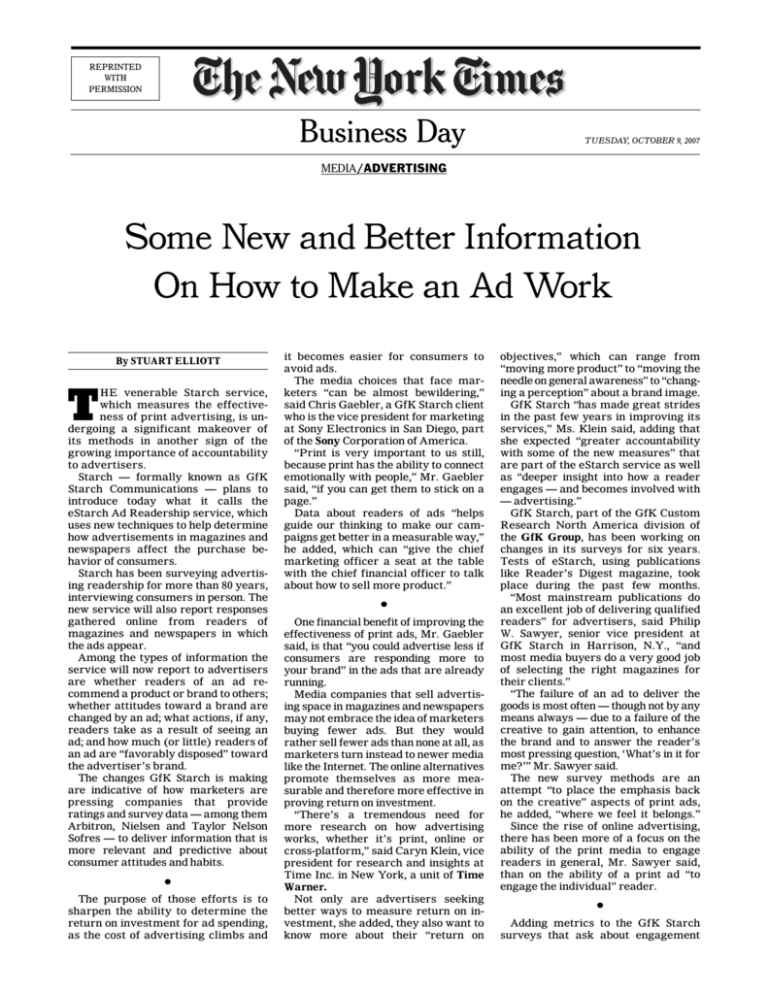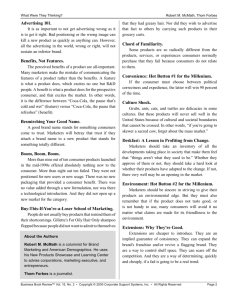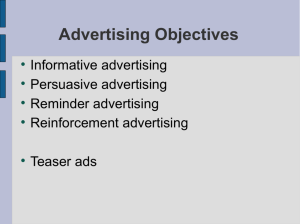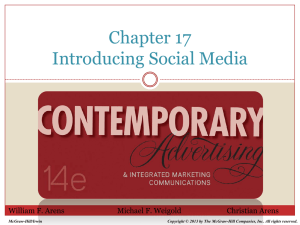GfK Starch
advertisement

REPRINTED WITH PERMISSION Business Day TUESDAY, OCTOBER 9, 2007 MEDIA/ADVERTISING Some New and Better Information On How to Make an Ad Work By STUART ELLIOTT T HE venerable Starch service, which measures the effectiveness of print advertising, is undergoing a significant makeover of its methods in another sign of the growing importance of accountability to advertisers. Starch — formally known as GfK Starch Communications — plans to introduce today what it calls the eStarch Ad Readership service, which uses new techniques to help determine how advertisements in magazines and newspapers affect the purchase behavior of consumers. Starch has been surveying advertising readership for more than 80 years, interviewing consumers in person. The new service will also report responses gathered online from readers of magazines and newspapers in which the ads appear. Among the types of information the service will now report to advertisers are whether readers of an ad recommend a product or brand to others; whether attitudes toward a brand are changed by an ad; what actions, if any, readers take as a result of seeing an ad; and how much (or little) readers of an ad are “favorably disposed” toward the advertiser’s brand. The changes GfK Starch is making are indicative of how marketers are pressing companies that provide ratings and survey data — among them Arbitron, Nielsen and Taylor Nelson Sofres — to deliver information that is more relevant and predictive about consumer attitudes and habits. • The purpose of those efforts is to sharpen the ability to determine the return on investment for ad spending, as the cost of advertising climbs and it becomes easier for consumers to avoid ads. The media choices that face marketers “can be almost bewildering,” said Chris Gaebler, a GfK Starch client who is the vice president for marketing at Sony Electronics in San Diego, part of the Sony Corporation of America. “Print is very important to us still, because print has the ability to connect emotionally with people,” Mr. Gaebler said, “if you can get them to stick on a page.” Data about readers of ads “helps guide our thinking to make our campaigns get better in a measurable way,” he added, which can “give the chief marketing officer a seat at the table with the chief financial officer to talk about how to sell more product.” • One financial benefit of improving the effectiveness of print ads, Mr. Gaebler said, is that “you could advertise less if consumers are responding more to your brand” in the ads that are already running. Media companies that sell advertising space in magazines and newspapers may not embrace the idea of marketers buying fewer ads. But they would rather sell fewer ads than none at all, as marketers turn instead to newer media like the Internet. The online alternatives promote themselves as more measurable and therefore more effective in proving return on investment. “There’s a tremendous need for more research on how advertising works, whether it’s print, online or cross-platform,” said Caryn Klein, vice president for research and insights at Time Inc. in New York, a unit of Time Warner. Not only are advertisers seeking better ways to measure return on investment, she added, they also want to know more about their “return on objectives,” which can range from “moving more product” to “moving the needle on general awareness” to “changing a perception” about a brand image. GfK Starch “has made great strides in the past few years in improving its services,” Ms. Klein said, adding that she expected “greater accountability with some of the new measures” that are part of the eStarch service as well as “deeper insight into how a reader engages — and becomes involved with — advertising.” GfK Starch, part of the GfK Custom Research North America division of the GfK Group, has been working on changes in its surveys for six years. Tests of eStarch, using publications like Reader’s Digest magazine, took place during the past few months. “Most mainstream publications do an excellent job of delivering qualified readers” for advertisers, said Philip W. Sawyer, senior vice president at GfK Starch in Harrison, N.Y., “and most media buyers do a very good job of selecting the right magazines for their clients.” “The failure of an ad to deliver the goods is most often — though not by any means always — due to a failure of the creative to gain attention, to enhance the brand and to answer the reader’s most pressing question, ‘What’s in it for me?’” Mr. Sawyer said. The new survey methods are an attempt “to place the emphasis back on the creative” aspects of print ads, he added, “where we feel it belongs.” Since the rise of online advertising, there has been more of a focus on the ability of the print media to engage readers in general, Mr. Sawyer said, than on the ability of a print ad “to engage the individual” reader. • Adding metrics to the GfK Starch surveys that ask about engagement and involvement should help “redress that imbalance,” he added. In other words, in contrast to what the media theorist Marshall McLuhan said, the medium is not the message; the message is the message. One finding from the tests of the new eStarch service showed that “if you love a brand, you’re more likely to read an ad” for that brand, Mr. Sawyer said. So ads aimed at consumers who may lack that ardor ought to be “more persuasive, offering more reasons to buy,” he added, rather than making the types of emotional pitches that would appeal to the brand’s existing customers. Mr. Gaebler of Sony Electronics described that result of the new research as particularly valuable. “The insight from Starch is to focus on the ones who love a brand first,” Mr. Gaebler said, which, for example, would mean “reinforcing with Sony fans that their next LCD TV should, of course, be a Bravia.” After that, “there’s an interesting opportunity to steal share from your competitors,” he added, “if you can identify an audience who is open to a competing brand” and then aim the right types of ads at them. Another finding, Mr. Sawyer said, is that word of mouth — that is, talking about a brand or product with the people you know — can be “the definable proof of engagement with an ad.” That could be significant because many marketers are seeking to stoke “buzz” about their brands by advertising online rather than in the traditional media like print. (#16259) Copyright © 2007 by The New York Times Company. Reprinted with permission. For subscriptions to The New York Times, please call 1-800-NYTIMES. Visit us online at www.nytimes.com. For more information about reprints contact PARS International Corp. at 212-221-9595 x210.







